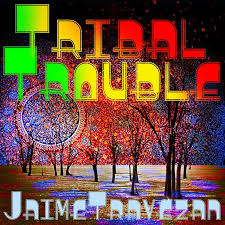Jaime Travezán is a versatile photographer with a rich background in photojournalism, fashion, and portraiture. He began his career covering impactful events like the Kosovo war, contributing to renowned publications such as The Guardian, The Times, El País, and more. His fashion photography has graced the pages of ID, Vogue, and Elle. Travezán’s portrait portfolio includes icons like Stephen Hawking, Pedro Almodóvar, and Sting. Currently, his focus leans toward Fine Arts projects, while also exploring music, GIFs, and video content. With numerous international awards to his name, Travezán continues to push creative boundaries, blending visual storytelling with artistic innovation.
Jaime Travezán’s “Tribal Trouble” is a masterclass in dynamic electronic music that defies easy categorization. The track’s deceptively calm opening serves as a brilliant contrast to what follows – an energetic explosion of tribal rhythms expertly fused with modern electronic elements.
Checkout the latest news: Opinion: T-Series hits Kunal Kamra with Copyright Notice After Building an Empire by Plagiarising & Piracy
True to its title, the track by Jaime Travezán blends tribal influences into its electronic framework with remarkable sophistication. What’s particularly impressive is how it manages to maintain its dance energy while taking listeners through such a varied emotional journey – from bright, optimistic passages to darker, more intense moments.
The unpredictability of “Tribal Trouble” by Jaime Travezán is one of its greatest strengths. Just when you think you’ve got the track figured out, it shifts direction, introducing new elements and emotional colors. These transitions are handled with impressive technical skill – each twist and turn feels organic despite the dramatic shifts in mood and intensity.
You may also like listening to: Get Lost in the Multicultural Rhythms of ETOLUBOV’s Dance Pop Oasis “VSELUBOV”
The production quality shines through in how cleanly these diverse elements are integrated. The tribal percussion, electronic textures, and atmospheric elements all work together to create something genuinely unique in electronic music.’
We had an opportunity to have a chat with Jaime Travezán about his new single and beyond. Keep reading to learn more.
1. Hey Jaime Travezán welcome to Sinusoidal. A big congratulations on your new single. “Tribal Trouble” takes listeners on an unpredictable journey. Starting calm before diving into energetic, tribal-infused electronica. Was this structure intentional from the beginning, or did it evolve organically during production?
A: Thank you so much for having me. As for “Tribal Trouble,” the structure was intentional from the start. Some of my previous songs also follow a similar structure in some ways. I love the element of surprise and the way a song can take you on a journey—like reading a novel. In this case, it moves from tranquility to euphoria, with the backdrop of African and Asian influences.
2. The song blends dance energy with emotional complexity. How did you manage to blend in such a wide range of emotions while keeping it cohesive?
A: It’s like going to a club—during the time you’re there, a lot can happen, sometimes even deeply emotional moments within the context of electronic music. Your emotional state can influence how a song feels to you. I wanted to capture and synthesize that experience with this track.
3. The unpredictability of the song is one of its most striking features. Did you set out to surprise the listener, or is that just how your creative process unfolded?
A: As I mentioned before, it was intentional from the beginning. However, as you develop a piece, new questions arise. Depending on the effort you put into answering them, you find different ways to shape the final outcome. I always try to stay away from what’s already been done—simply because it has been done, and there’s nothing left to explore there.
As for surprising the listener, I appreciate those who take the time to engage with my music, but ultimately, I make music for myself. I don’t want to create with the thought of whether the public will like it or not—that wouldn’t be very honest. That said, I do enjoy sharing my work in case someone connects with it. Even if they hate it so much they can’t stop thinking about it!
My goal isn’t recognition; it’s about having fun and challenging myself. I have this anarchic way of thinking—if things don’t match, they should match, or at least we should try. That’s the challenge. Since photography is my profession and music is my hobby, I can take all kinds of liberties.
Three years ago, I made a song with this idea in mind. I asked myself: what are the most unlikely musical styles to mix in a single track? The result was “Chamber Salsa”—a blend of 17th-century chamber music with harpsichord, mixed with rap and salsa. Did it work for the public? I have no idea. Probably not. But did I have fun creating it? Absolutely. I laughed so much. And in that sense, the song was a success—because it made me happy. Even more so considering that salsa is a genre I don’t particularly like, but in that context, it worked.
4. Many electronic tracks follow a predictable build-drop formula, but this song defies convention. Did you consciously reject traditional structures?
A: Absolutely. Making a formulaic track is incredibly easy—especially these days. You can just buy the trending or most popular song from any digital store, upload it to your DAW, and instantly analyze its structure—the BPM, the rise and fall, the key, the musical scale, etc. Replace those elements with similar sounds and beats, and there you have it: a track. But a copycat track. That’s why so much music today sounds the same.
5. Looking ahead, do you see yourself releasing a full album, or are you more interested in exploring individual experimental tracks like “Tribal Trouble”?
A: Last year, I released an eight-track album, “Everybody Is So Funny,” and I have another one that’s practically finished—I just need time for a final revision and to title the songs. What I haven’t decided yet is whether to release it as a full album or drop the tracks one by one. They work well together, and for once, there’s no House influence. Instead, the album leans toward a deeper, more experimental sound.
6. What legacy do you hope to leave in both the visual and musical worlds?
A: I’ve never thought about that. I focus only on the present and the immediate future.
To be a part of Jaime Travezán’s musical journey, you can follow him on Instagram
Enjoy listening to “Tribal Trouble” by Jaime Travezán here.
Check out our playlists here!
Check out our YouTube channel for music reviews, playlists, podcasts, and more!
Promotional Disclaimer: The content in this post has been sponsored by the artist, label, or PR representative to help promote their work.
Coffee, Creativity, and Constancy.











